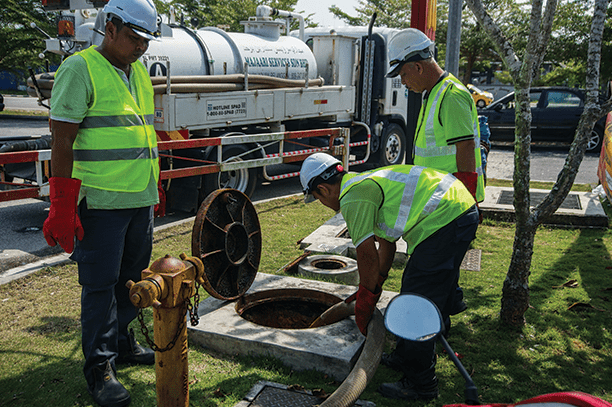Congratulations on your new home! As you settle into your surroundings, familiarizing yourself with your septic system is an essential step toward ensuring its long-term health and functionality. Unlike homes connected to municipal sewer systems, septic systems require specific care and maintenance practices.
In this blog post, we’ll explore what to expect after your septic system installation in Newberg, Wilsonville, Sherwood, Molalla, and surrounding areas, offering valuable insights and guidance for new homeowners like you. From understanding the basic components of your septic system to learning about ongoing maintenance requirements, we’ve got you covered. Let’s dive in and discover how to keep your septic system running smoothly for years to come.
Initial Inspection and Settling
Following your septic system installation from a reputable company like American On-Site Septic, a qualified professional will conduct a final inspection. This assessment verifies that the system is installed according to code, functions properly, and adheres to all local regulations. During this time, our technician will also provide a detailed overview of your specific system, including its location, tank size, and any unique maintenance requirements.
The initial period after installation is crucial for properly settling the septic tank and drainfield. During this time, the biological community within the tank begins to establish itself. It’s important to practice water conservation during this period to allow the solids to settle effectively and avoid overwhelming the new system. Ideally, your septic system installation company should advise you on specific water usage recommendations for this settling phase.
System Inspection and Maintenance
Septic Tank Pumping: Regular pumping is a critical aspect of septic system maintenance. The pumping frequency depends on several factors, including household size, wastewater volume, and tank capacity. Septic tank pumping is generally recommended for a typical household every 3-5 years. However, a qualified septic system professional can assess your specific needs and recommend a customized pumping schedule.
In addition to pumping, it’s advisable to have your septic system inspected by a professional like American On-Site Septic every 2-3 years. As mentioned earlier, a thorough inspection can identify potential problems early on, preventing them from escalating into costly repairs. During an inspection, the technician will assess the tank’s liquid levels, check for any blockages or leaks in the drainfield, and ensure all components function optimally.
Here are some additional septic system maintenance tips to keep your system running smoothly:
1. Avoid Harsh Chemicals
Many household cleaners and drain openers contain harsh chemicals that can disrupt the delicate bacterial balance within your septic tank. You should opt for eco-friendly cleaning products whenever possible.
2. Enzyme Treatments
Leading septic system installation experts in Molalla reveal that you can consider using enzyme treatments periodically to help break down organic waste within the tank and enhance system efficiency. Consult a septic professional for recommendations on suitable enzyme products.
3. Proper Drainage
Ensure that all wastewater from your property, including laundry and sump pump discharge, flows into the septic system. Directing rainwater or runoff away from the drainfield is also important to prevent the system from overflowing.
Contact our team at 503-822-7903 for an accurate septic system installation, aftercare, and maintenance estimate.
Water Usage and Waste Disposal
Water conservation is a key component of septic system maintenance. Septic systems in Sherwood, Wilsonville, Newberg, and nearby locations are designed to handle a specific wastewater volume. Excessive water usage can overwhelm the system, leading to clogs, backups, and potential drainfield failure. Here are some simple water conservation tips to keep in mind:
- Install low-flow showerheads and faucets.
- Fix leaky toilets and faucets promptly.
- Run dishwashers and washing machines only when full.
- Take shorter showers instead of baths.
- Water your lawn and garden efficiently.
Just as important as water usage is what goes down the drain. Septic systems rely on specific bacteria to break down waste. Certain materials can disrupt this delicate balance and clog your septic system. Here’s what to avoid flushing:
1. Fats, oils, and grease (FOG)
These substances solidify and clog pipes, preventing proper wastewater flow.
2. Coffee grounds
Coffee grounds can clump together and form a thick layer that’s difficult to decompose.
3. Eggshells and food scraps
Top septic system aftercare companies in Sherwood reveal that these can attract grease and encourage the growth of solids-consuming bacteria that can disrupt the natural balance in your septic tank.
4. Non-biodegradable items
Diapers, wipes, dental floss, and feminine hygiene products are not designed to break down and can lead to severe clogs and system malfunctions.
5. Harsh chemicals
Drain cleaners and bleach may seem like a quick fix for clogged drains, but they can kill the beneficial bacteria needed for proper waste decomposition. Choose natural drain cleaning methods or consult a septic professional like American On-Site Septic for recommendations.
Monitoring for Success
While a properly maintained septic system operates smoothly, there can be signs that indicate potential problems. Here’s what to watch out for:
1. Slow drains
This could indicate a clog in the drain pipes or septic tank.
2. Sewage backups
This serious issue indicates a blockage or overflow in the septic system. Avoid using any plumbing fixtures until the problem is resolved, and contact a licensed septic professional from American On-Site Septic immediately.
3. Strong sewage odors
Sewage odors around your drainfield or outside your home can indicate a ventilation issue, a leak in the tank or drainfield, or a system overload. Investigate the source of the odor and contact a septic contractor from a reliable firm like American On-Site Septic if necessary.
4. Soggy or overly green patches around the drainfield
This could be a sign of a clogged drainfield or improper drainage. Avoid driving or placing heavy objects on the drainfield, and consult a credible septic professional like American On-Site Septic for inspection.
By being observant and addressing any potential issues promptly, you can help prevent minor problems from escalating into costly repairs.
Establishing a Monitoring Routine
Here are some simple practices you can incorporate into your routine to monitor your septic system’s health:
1. Regular Visual Inspections
Walk around your drainfield every few months to check for any pooling water, soggy patches, or unusual odors.
2. Track Water Usage
Monitor your water usage patterns and avoid sudden spikes in water consumption that could overwhelm the system.
3. Septic Tank Pumping Schedule
Maintain a record of your septic tank pumping history and schedule appointments based on your household size and system capacity. Our team at American On-Site Septic can help you establish a customized pumping schedule.
Living with a Septic System: Long-Term Considerations
1. System Upgrades
As your household size or water usage patterns change over time, your septic system’s capacity may need to be reevaluated. American On-Site Septic offers a variety of septic system upgrade options to ensure your system continues to meet your needs. These upgrades can include adding an effluent filter to improve wastewater quality before it reaches the drainfield or installing a larger septic tank to accommodate increased wastewater volume.
2. Responsible Waste Management
Beyond the items mentioned previously, there are additional steps you can take to promote a healthy septic system and minimize the need for future repairs:
3. Garbage Disposal Usage
While garbage disposals are convenient, they can increase solid waste in your septic tank. Consider composting food scraps or limiting your use of the garbage disposal.
4. Water-Efficient Appliances
According to the leading septic system installation contractors in Molalla, opt for water-efficient models like low-flow toilets and washing machines when replacing appliances. This will help you conserve water and reduce the load on your septic system.
Final Takeaway
A well-functioning septic system is vital for a comfortable and sustainable home experience, especially for those residing in areas like Molalla, Newberg, Sherwood, and Wilsonville, where municipal sewer connections are uncommon.
With the insights and guidance provided in this guide, you can confidently navigate the nuances of septic system ownership. Remember, at American On-Site Septic, we’re more than just a service provider—we’re your partners in maintaining a healthy and sustainable home environment.
Whether you need septic system installation, aftercare, maintenance, or upgrades, our dedicated team is here to support you every step of the way. With over twenty years of experience and expertise serving homeowners like you, we’re committed to delivering top-quality service and ensuring your septic system operates smoothly for years to come.
Contact us at 503-822-7903 to schedule an appointment and experience the difference with American On-Site Septic today. Your home’s health and comfort are our top priorities, and we look forward to serving you.






